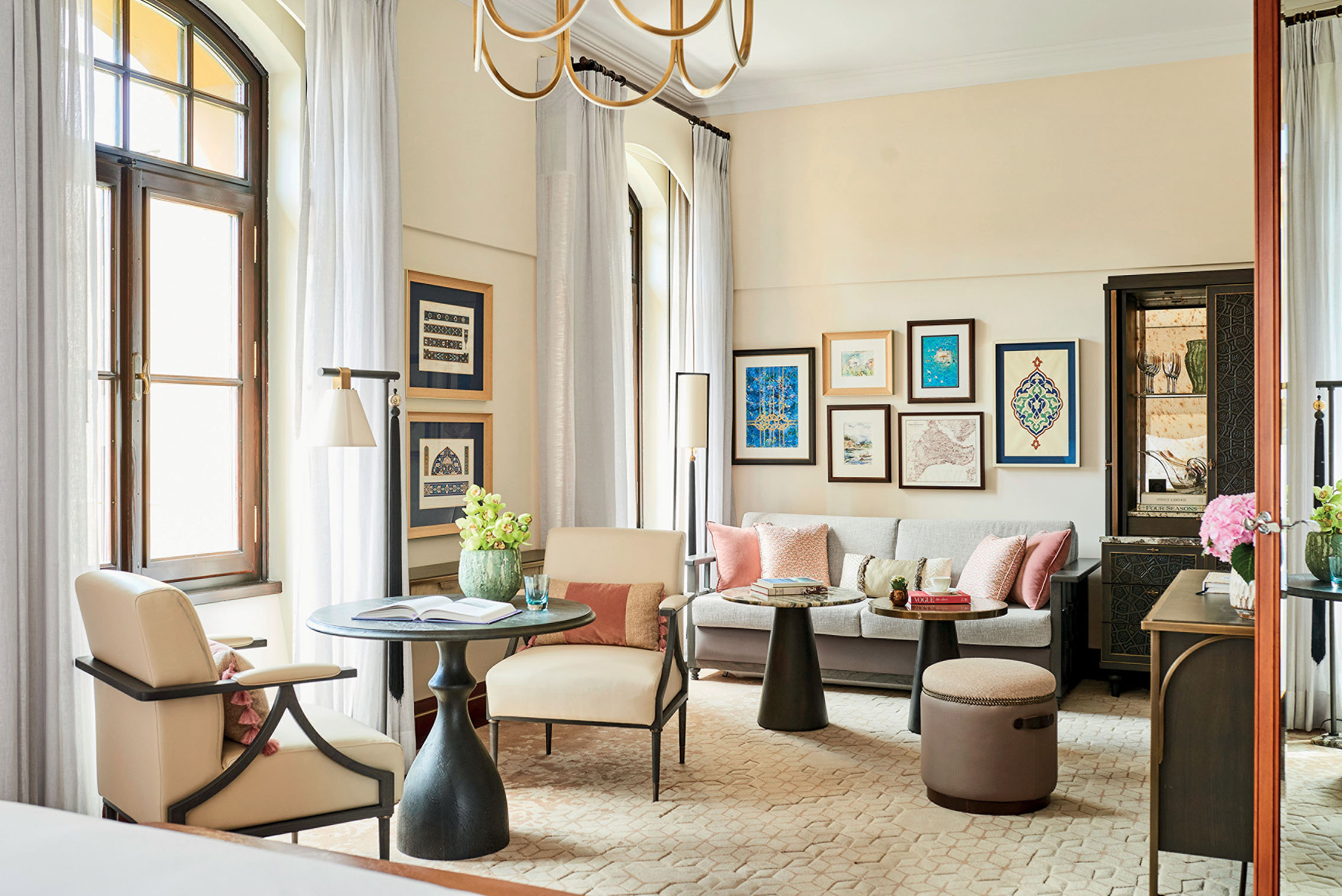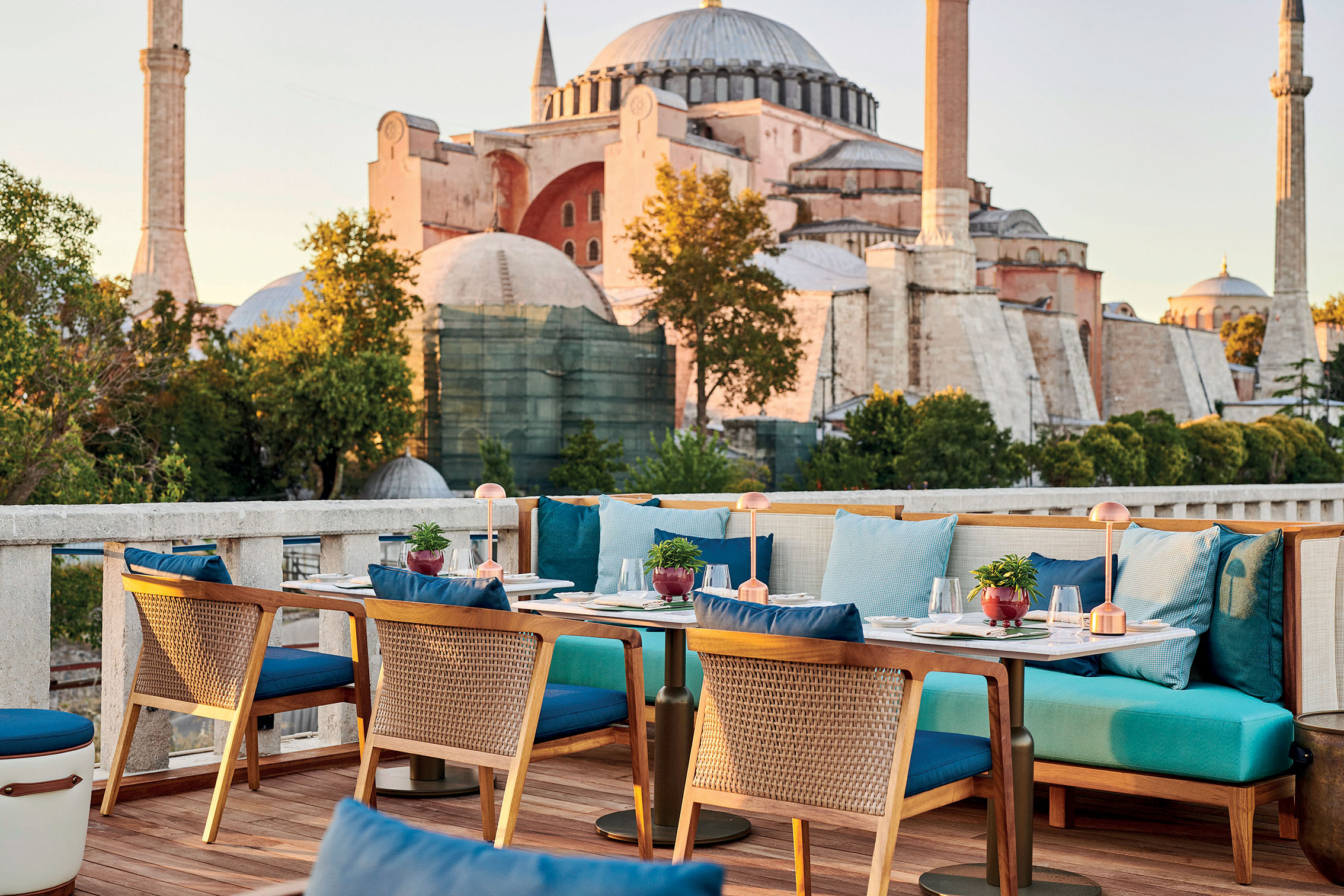Originally an Ottoman guest house before being converted into a prison, the Four Seasons Istanbul Sultanahmet has been meticulously renovated by interior design studio Goddard Littlefair. Words by Zana Wilberforce

Having witnessed the rise and fall of empires, Istanbul is a mesmerising metropolis and the only place in the world to bridge two continents (Europe and Asia), resulting in a recognisable design aesthetic shaped by the city’s abundant tales and legends. Nestled among the serpentine streets of Istanbul’s Old City by the Hagia Sophia (Aya Sofya) and the Blue Mosque, the Four Seasons Sultanahmet is ideally located for design lovers in need of a culture fix. The building’s exterior is dressed in a cheery lick of yellow paint that’s fit for a Wes Anderson set, overlooking the silhouette of domes and pointed minarets that jut out against the cerulean skyline.

Re-opening in 2022 following a sprawling redesign by design duo Martin Goddard and Jo Littlefair of London based Goddard Littlefair, this striking neoclassical building was formerly a guesthouse for the Sultan’s visitors during Ottoman rule in 1917. Even when the building was converted into a prison in 1918, the dramatic domes and towers of the original structure remain intact, making it difficult to envision its former life as anything but a luxury abode made for royalty. Anything that has been transformed in the redesign has been meticulously considered, paying homage to the location’s rich heritage. “In order to do this, the design team became fully immersed in the local culture, while being careful to always distil design through a contemporary filter,” says Goddard Littlefair.

Restoration projects certainly aren’t new to the Four Seasons brand, so it’s no surprise that Goddard Littlefair sought to honour the location’s many layers of history, while staying true to the brand’s luxury DNA in the redesign process. “Preservation, restoration, and renovation are the places from where we start. All the interior architecture was retained throughout. Rather than stripping everything down, we added fresh new layers where necessary. The ability to reimagine past schemes without removing existing features is fundamental to the design here,” says Goddard Littlefair.
“One of the best examples of this approach is in the guest rooms and bathrooms,” they add. “Existing joinery was retained but treated to bring it in line with the new concept and overall design scheme. Additional elements such as the pre-existing fitted blind boxes and black-out roller blinds were in excellent condition, so we decided to keep them as they are. Instead, the window treatments were elevated with new soft linen sheers.”

As a result, all 65 rooms and suites feature certain quirks that make them unique in design, which can be a challenge to achieve in period buildings. Layered with soft textures, the Executive Suite overlooks the landscaped courtyard which sits at the heart of the hotel, softening the sun’s rays that shine through the linen sheers. A circular coffee table is surrounded by upholstered stools that have been carefully designed to overlap, symbolising the Chintamani pattern found in traditional Islamic design. Working in collaboration with local artisans, custom pieces were sourced by Goddard Littlefair including antique velvets, metal chandeliers and beautiful blown glass. Large enough for families, the Executive Suite is kitted out with a full marble bathroom, excellent storage space, and full-sized Diptyque products. Small tweaks were made to the sleek but spacious bathrooms, which were originally clad in white marble in the 1996 renovation. “By adding a new vanity, mirror and wall lights, we were able to update the bathrooms without sending unnecessary quantities of natural material to landfill,” adds Goddard Littlefair.
Other architectural elements have been preserved, including the entryway’s oversized timber doors and the pale terracotta arches that greet guests in the lobby. Some original tiling can be found in an entryway that leads out to the courtyard. These handmade ceramic tiles were originally placed in the bathroom of the former prison before being scattered across various corners of the hotel. In the working masjid (prayer room), patterned blue Iznik tile panels line the walls similar to the Blue Mosque. If you look closely enough, some original marble pillars have words, symbols and markings from the former writers, artists and journalists who were held captive within these walls.

Enjoy modern Turkish cuisine at AVLU restaurant, the circular courtyard restaurant which is the most playful area of the hotel in terms of design, featuring patterned tiles, bronze tones and flashes of pistachio that blend seamlessly with the elegant colour palette. Look up to discover the curved ceiling which has been re-clad with light timber clapperboard to reference the local architecture. “The marble floor is also new, and both of these elements feel intrinsically influenced by the local vernacular without being a direct recreation. The sun imagery on the ceiling at AVLU restaurant is a nod to the famed Turkish sunrises, fostering a sense of connection to the surrounding natural beauty of Istanbul,” says Goddard Littlefair. Flanked by floor-to-ceiling windows, this stylish restaurant features bespoke bronze lanterns that dangle down from the ceiling, a detail that nods to the Ottoman era. Just next door, Lingo Lingo’s private dining space, which serves up succulent plates of mezze with a seafood twist, is inspired by elaborate Byzantine food halls, incorporating frescoed ceilings and weighty floor-to-ceiling curtains.

The lounge area by AVLU is just the spot for enjoying pistachio-flavoured pastries with bottomless cups of çay (Turkish tea) or lahmacun – wood-fired Turkish-style pizza topped with minced lamb, to be rolled and eaten as a wrap with fresh herbs, tomatoes, and a squeeze of lemon. Step back inside the polished lobby to discover La Pistache, a plush patisserie headed up by the hotel’s in-house pastry chef. The lobby lounge features a striking collection of handwoven Turkish Kilim textiles, while potted plants decorate the interior and complement the grand pale terracotta arches shaped in the form of a headscarf. Elsewhere, contemporary pieces juxtapose Ottoman period art, linking the past and present. Artwork played an important role in the redesign process, another theme close to the Four Seasons brand. “We scoured boutiques and bazaars for individual pieces for the communal areas,” adds Goddard Littlefair. “This meant that much of the hotel was designed in real time on the ground in Istanbul. The owners of the hotel had some original pieces that they had invested in. In the guest bedrooms, we reframed and arranged them to replicate a contemporary gallery format.” Some pieces were specially commissioned for the project, including an intricate painting of Istanbul by Kenan Işık, a local contemporary artist who has also had his work featured in a solo exhibition at the brand’s sister hotel in Istanbul, Four Seasons at The Bosphorus.
Elsewhere, recurring feather motifs can be spotted in and around the reception area and communal spaces, adding texture in unexpected moments. “Feathers have a deep historical and cultural significance, often being associated with high status and respect. Seagulls are often seen circling around the city which is another reason for including this motif,” says Goddard Littlefair.
This wouldn’t be a Four Seasons property without a spa, a calming space complete with a Turkish Hammam that follows the traditional formula of a warm bath, a cleansing scrub, and an exquisite foam massage. Though small in scale, the proportions have been cleverly arranged to make the most of the available space in the downstairs area. A refined and soothing colour palette beautifully complements the exposed copper metalwork, playfully nodding to ancient Anatolian craftsmanship.

